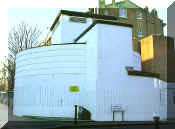
The Bombings of 1940 forced a reappraisal of deep-shelter policy and at the end
of October the Government decided to construct a system of deep shelters linked
to existing tube stations. London Transport was consulted about the understanding
that they were to have the option of taking them over for railway use after the
war. With the latter point in mind, positions were chosen on routes of possible
north-south and east-west express tube
railways. It was decided that each shelter would comprise two parallel tubes16
foot 6 inches internal diameter and 12,000 feet long and would be placed below
existing station tunnels at Clapham South, Clapham Common, Clapham North,
Stockwell, Oval, Goodge Street, Camden Town, Belsize Park, Chancery Lane and St.
Paul's. It may be assumed that at these points the deep-level express tubes would
have no stations as the diameter was too small.
Each tube would have two decks, fully equipped with bunks, medical posts, kitchens
and sanitation and each installation would accommodate 9,600 people at a
construction cost of 15 pounds per head. In the event, the capacity was reduced
to 8000 as a result of improved accommodation standards and the actual cost
varied between 35 and 42 pounds per head. Work began on November 27th 1940 and
it was hoped to have the first shelters ready by the following summer. There
were great difficulties in obtaining labour and material and when the blitz
abated the Government had second thoughts. The old bogey of 'deep level
mentality' was brought out of the cupboard by those who opposed, in the middle of 1941 a
select committee on national expenditure recommended that no further deep
shelters be built, but those started should be completed. Work at St. Paul's was
abandoned in August 1941 as it was feared the foundations
of the cathedral might be affected. Oval was also abandoned shortly after this
as large quantities of water were encountered. The first complete
shelter was ready in March 1942 and the other seven were finished later in that
year. The Board then urged the government to open the shelters to relieve the
strain on the tube stations, but the Cabinet were alive to the great cost of
maintaining the deep shelters once they were opened and decided to keep them in
reserve pending an intensification of the bombing. Towards the end of 1942 part
of Goodge Street shelter was made available for General Eisenhower's headquarters
and later two others were adapted for Government use. Another was converted to a
hostel for American troops and sections of the remaining four were used to
billet British soldiers. These uses were maintained throughout 1943 despite
agitation that the shelters should be opened for their proper purpose.
At the beginning of 1944, the air attack warmed up again and on June 13th the V1
assault began to be followed on September 8th by the V2 rockets which then came over intermittently until March 27th 1945. The arrival of
the flying bombs finally moved the Government to open the shelters to the public. Stockwell was available from July 9th
1944, Clapham North from July13th, Camden Town from July 16th, Clapham South from July 19th and
Belsize Park from July 23rd. The other three remained in Government use. Regular shelterers
at nearby tube stations and homeless people were given admission tickets, but demand was not high and by September some of the
spaces available were made available to troops on leave. The highest recorded nightly
population was 12,297 bon July 24 1944, about one third of total capacity. On October 21st, two of the shelters were closed again and
nightly use fell until by January 1945 only about 25,000 people were using the tube stations
and deep shelters. The last air-raid warning of the war was sounded on March 28th 1945 (the European war ended on May 8th), but about
12,000 homeless people and 'squatter's' continued to sleep in the tubes until
May, when the bunks on the platforms were removed and a start was made on tidying up
the stations. The 79 shelters stations were closed to shelterer's after the night of May
6th and the Board breathed a deep sigh of relief.
After the war, various uses were found for the Government deep shelters,
including the storage of documents and the provision of overnight
accommodation for students and troops. Goodge Street continued in use as an army
transit centre until it was damaged by fire on the night of May 21st 1956. The
fire coincided with Parliamentary consideration of a Government Bill seeking
power to take over the shelters (The Underground Works (London) Bill) and the Minister of Works assured the Commons they would not again
be used for human occupation in peacetime (although no one was killed, the fire had
caused some alarm and proved difficult to put out). During the progress of the Bill, it was revealed that the option for railway use had
been retained only on the three Clapham shelters and the adjacent one at Stockwell.'
In the 1950's Chancery Lane was converted into a 500 line trunk telephone exchange
with a six weeks food supply and its own artesian well. It was connected to 12 miles of 7 foot diameter deep cable tunnels
constructed since the war by the Post Office. Camden Town has been used as a set for
'Dr. Who' and 'Blakes 7'.
These photo's were taken quickly on a cheap digital camera (when digital cameras were not mega pixel, this one was VGA!) please excuse the quality.
Text © Alan A. Jackson's 'Rails through the clay'